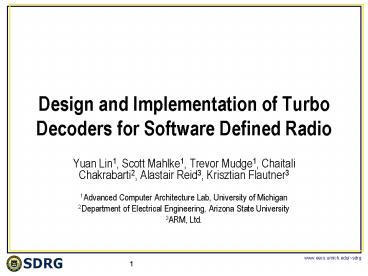Design and Implementation of Turbo Decoders for Software Defined Radio - PowerPoint PPT Presentation
Title:
Design and Implementation of Turbo Decoders for Software Defined Radio
Description:
Yuan Lin1, Scott Mahlke1, Trevor Mudge1, Chaitali Chakrabarti2, ... SIMD permutation network. smart DMA. Beyond 3G. Support for higher throughput 3G protocols ... – PowerPoint PPT presentation
Number of Views:95
Avg rating:3.0/5.0
Title: Design and Implementation of Turbo Decoders for Software Defined Radio
1
Design and Implementation of Turbo Decoders for
Software Defined Radio
- Yuan Lin1, Scott Mahlke1, Trevor Mudge1, Chaitali
Chakrabarti2, Alastair Reid3, Krisztian Flautner3 - 1Advanced Computer Architecture Lab, University
of Michigan - 2Department of Electrical Engineering, Arizona
State University - 3ARM, Ltd.
2
Advantages of Software Defined Radio
- Multi-mode operations
- Lower costs
- Faster time to market
- Prototyping and bug fixes
- Chip volumes
- Longevity of platforms
- Protocol complexity favors software dominated
solutions - Enables future wireless communication innovations
- Cognitive radio
3
SDR Design Objectives for W-CDMA
- Programmable processor
- Same hardware should support Turbo decoder as
well as other DSP algorithms - Throughput requirements
- 2Mbps
- Power constraints
- 100mW 500mW
4
SODA DSP Processor for SDR
5
SODA PE SIMD Pipeline
6
SODA PE SIMD Shuffle Network
7
SODA PE Scalar Pipeline
8
Turbo Decoder on SODA
- Most computationally intensive algorithm in
W-CDMA - Hardest algorithm to parallelize
- Implementation outline
- MaxLogMAP trellis computation with SIMD
operations - Parallelizing trellis computations through
sliding window - Interleaver implementation
9
Trellis Computation on SODA
- Two types of trellis diagram configurations
- Blue edges (0-branch), Red edges (1-branch)
- Mapping trellis of size S onto SODA of SIMD size
T
10
Forward Trellis on SODA (S T)
11
Handling SIMD Misalignment
12
Sliding Window on SODA
- Problem
- W-CDMA uses K4, 8 wide trellis
- SODA has 32-wide SIMD
- Solution
- parallelize trellis computation by implementing
sliding window - fully utilize SIMD width
- achieving higher-throughput in the process
13
Sliding Window Parallelization
14
Sliding Window on SODA (S lt T)
15
Turbo Decoder System Operations
16
SODA DMA Modifications
- Traditional DMA controller
- Designed for block data transfer
- 1 source and 1 destination address per block
- Modified DMA controller
- Adding data interleaving functionality to DMA
- Needs to handle scalar data transfers
- 1 source and 1 destination address per scalar
17
Achieved Performance on SODA
- SODA operates at 400MHz
- Can achieve 2.08Mbps with I 5
18
Conclusion Future Work
- Implementation summary
- SODA consumes lt100mW in 90nm
- Meets W-CDMA throughput requirements
- Hardware features
- wide SIMD execution
- SIMD permutation network
- smart DMA
- Beyond 3G
- Support for higher throughput 3G protocols
- Multi-processor SODA for Turbo decoder
- LDPC decoding
19
Questions?
- www.eecs.umich.edu/sdrg































